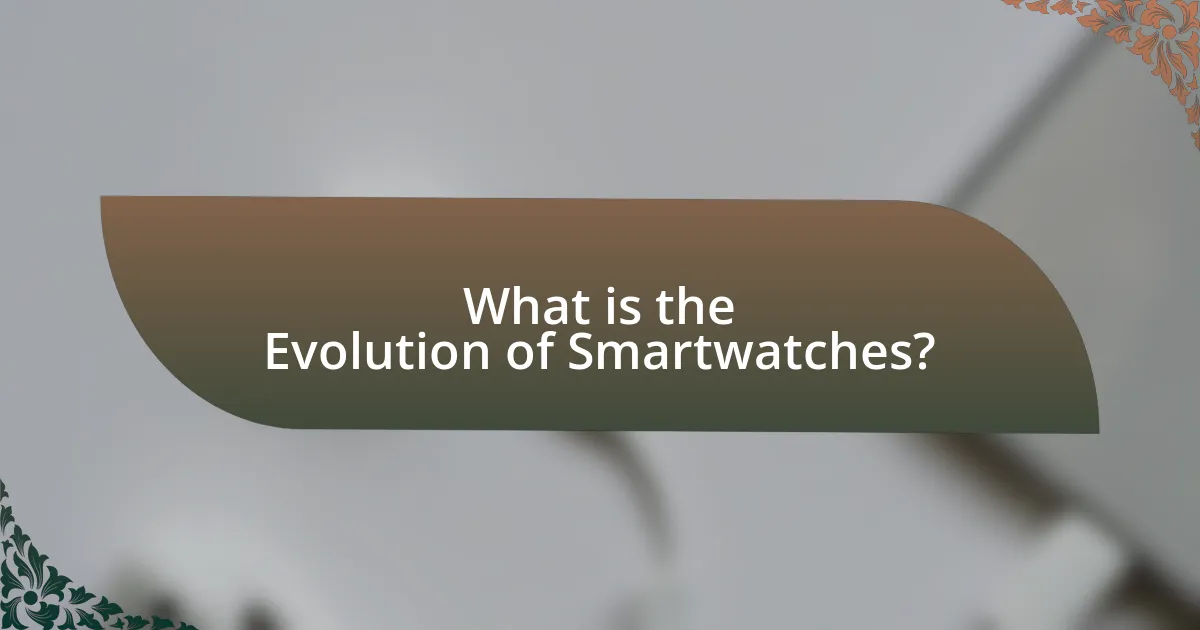The article focuses on the evolution of smartwatches, detailing their development from early models in the 2000s to the advanced multifunctional devices available in 2023. It highlights key technological advancements, such as improved health monitoring, enhanced connectivity, and longer battery life, which have shaped user experience and market trends. Additionally, the article outlines essential features consumers should consider when selecting a smartwatch, including compatibility with smartphones, app availability, and health tracking capabilities. The significance of user needs and manufacturer innovations in driving smartwatch evolution is also discussed, providing a comprehensive overview of the current landscape and future expectations in smartwatch technology.

What is the Evolution of Smartwatches?
The evolution of smartwatches began in the early 2000s with devices like the Fossil Wrist PDA, which combined traditional watch features with basic PDA functionalities. In 2012, the introduction of the Pebble smartwatch marked a significant shift, as it allowed users to receive notifications and run apps via Bluetooth connectivity with smartphones. This was followed by major tech companies entering the market; in 2015, Apple launched the Apple Watch, which integrated health tracking, notifications, and a wide range of apps, setting a new standard for smartwatches. By 2020, advancements included features like GPS, heart rate monitoring, and cellular connectivity, making smartwatches more independent from smartphones. The market has continued to grow, with a projected increase in global smartwatch shipments to over 200 million units by 2023, reflecting their increasing popularity and functionality.
How have smartwatches changed over the years?
Smartwatches have evolved significantly over the years, transitioning from basic fitness trackers to multifunctional devices. Initially, early models primarily focused on timekeeping and basic notifications, but advancements in technology have enabled features such as health monitoring, GPS navigation, and mobile payments. For instance, the introduction of heart rate sensors and ECG capabilities in models like the Apple Watch Series 4 marked a pivotal shift towards health-centric functionalities. Additionally, the integration of third-party apps and improved battery life has enhanced user experience, making smartwatches more versatile and essential in daily life. As of 2023, smartwatches now offer advanced features like sleep tracking, blood oxygen monitoring, and seamless connectivity with smart home devices, reflecting their transformation into comprehensive health and lifestyle management tools.
What were the first smartwatches like?
The first smartwatches were basic devices that primarily functioned as digital watches with limited connectivity features. They typically included functionalities such as timekeeping, alarms, and basic fitness tracking, but lacked the advanced capabilities seen in modern smartwatches. For instance, the Seiko Data 2000, released in 1983, allowed users to store data and connect to a computer, while the IBM WatchPad, introduced in 2001, featured a touchscreen and could display emails and calendar events. These early models laid the groundwork for the more sophisticated features found in contemporary smartwatches, such as app integration and health monitoring.
What technological advancements have influenced smartwatch development?
Technological advancements that have influenced smartwatch development include improvements in sensor technology, battery efficiency, and connectivity options. Enhanced sensors, such as heart rate monitors and GPS, allow for more accurate health tracking and navigation. Battery efficiency advancements enable longer usage times, with some smartwatches now lasting several days on a single charge. Additionally, the integration of Bluetooth and Wi-Fi connectivity has improved the ability to sync with smartphones and access the internet, enhancing functionality and user experience. These advancements collectively contribute to the growing popularity and capabilities of smartwatches in the market.
Why is the evolution of smartwatches significant?
The evolution of smartwatches is significant because it marks a transformative shift in personal technology, integrating advanced health monitoring, communication, and convenience into a compact wearable device. This evolution has led to features such as heart rate monitoring, GPS tracking, and mobile payment capabilities, which enhance user experience and promote health awareness. For instance, a report by Statista indicates that the global smartwatch market is projected to reach approximately 400 million units by 2025, reflecting growing consumer demand and technological advancements. This trend underscores the importance of smartwatches in modern life, as they increasingly serve as essential tools for health management and connectivity.
How do user needs shape smartwatch features?
User needs significantly shape smartwatch features by driving the development of functionalities that enhance convenience, health monitoring, and connectivity. For instance, the demand for fitness tracking has led manufacturers to integrate advanced sensors for heart rate monitoring, GPS, and activity tracking, which are now standard in many models. According to a report by Statista, 45% of smartwatch users prioritize health and fitness features, indicating that user preferences directly influence design and technology investments in this sector. Additionally, the need for seamless connectivity with smartphones has resulted in features like notifications, calls, and music control being incorporated into smartwatches, aligning with user expectations for a cohesive digital experience.
What role do manufacturers play in smartwatch evolution?
Manufacturers play a crucial role in the evolution of smartwatches by driving innovation, enhancing technology, and shaping market trends. They are responsible for developing new features such as health monitoring, GPS functionality, and integration with smart home devices, which have become standard in modern smartwatches. For instance, companies like Apple and Samsung have introduced advanced sensors and software capabilities that allow for real-time health tracking, significantly influencing consumer expectations and industry standards. Additionally, manufacturers invest in research and development to improve battery life and user interfaces, further propelling the smartwatch market forward. Their strategic decisions regarding design, pricing, and marketing also impact consumer adoption rates and the overall growth of the smartwatch ecosystem.

What are the Key Features of Smartwatches in 2023?
The key features of smartwatches in 2023 include advanced health monitoring, enhanced connectivity, and improved battery life. Advanced health monitoring systems now offer features such as ECG, blood oxygen saturation tracking, and sleep analysis, allowing users to gain deeper insights into their health. Enhanced connectivity is facilitated through 5G support and seamless integration with smartphones and smart home devices, enabling real-time notifications and control. Additionally, battery life has significantly improved, with many models offering multi-day usage on a single charge, addressing a common user concern. These features reflect the ongoing evolution of smartwatches, making them more functional and user-friendly.
What new functionalities should users expect in 2023 smartwatches?
In 2023, users should expect smartwatches to feature advanced health monitoring capabilities, including blood glucose tracking and improved sleep analysis. These functionalities are driven by technological advancements in sensor accuracy and data analytics, allowing for real-time health insights. For instance, companies like Apple and Samsung are integrating non-invasive glucose monitoring technology, which could significantly aid diabetes management. Additionally, enhanced sleep tracking algorithms are being developed to provide users with more detailed insights into their sleep patterns, contributing to better overall health management.
How do health monitoring features enhance user experience?
Health monitoring features enhance user experience by providing real-time insights into personal health metrics, which fosters a greater sense of awareness and control over one’s well-being. These features, such as heart rate monitoring, sleep tracking, and activity logging, allow users to set health goals and receive feedback on their progress, thereby promoting healthier lifestyle choices. For instance, a study published in the Journal of Medical Internet Research found that individuals using wearable health technology reported increased motivation to exercise and improved health outcomes. This direct correlation between health monitoring and user engagement demonstrates how these features significantly enrich the overall smartwatch experience.
What advancements in battery life are being introduced?
Advancements in battery life for smartwatches include the introduction of solid-state batteries, which offer higher energy density and longer lifespan compared to traditional lithium-ion batteries. These solid-state batteries can potentially increase battery life by up to 50% while reducing charging times significantly. Additionally, energy-efficient processors and software optimizations are being implemented, allowing smartwatches to consume less power during operation. For instance, the latest smartwatch models utilize low-power display technologies, such as OLED, which further enhance battery longevity by minimizing energy usage during screen-on time.
How do design and usability impact smartwatch selection?
Design and usability significantly influence smartwatch selection by affecting user satisfaction and functionality. A well-designed smartwatch that is aesthetically pleasing and comfortable to wear encourages users to adopt it as part of their daily routine. Usability factors, such as intuitive interfaces and responsive touchscreens, enhance the overall user experience, making it easier for individuals to access features and applications. Research indicates that 70% of consumers prioritize design and usability when choosing wearable technology, highlighting their critical role in purchase decisions.
What materials are trending in smartwatch design?
Trending materials in smartwatch design include titanium, ceramic, and recycled metals. Titanium is favored for its lightweight and durable properties, making it ideal for active users. Ceramic offers a premium aesthetic and scratch resistance, appealing to luxury markets. Recycled metals are gaining traction due to sustainability concerns, aligning with consumer preferences for eco-friendly products. These materials reflect a shift towards both functionality and environmental responsibility in smartwatch design.
How does user interface design affect functionality?
User interface design significantly affects functionality by determining how users interact with a device and access its features. A well-designed interface enhances usability, allowing users to navigate efficiently, while a poorly designed interface can lead to confusion and hinder performance. For instance, research by Nielsen Norman Group indicates that intuitive design can reduce user errors by up to 50%, demonstrating that effective user interface design directly correlates with improved functionality and user satisfaction.

What Should Consumers Look for When Choosing a Smartwatch in 2023?
Consumers should prioritize battery life, health tracking features, compatibility with smartphones, and app availability when choosing a smartwatch in 2023. Battery life is crucial as many models now offer multi-day usage, with some exceeding a week on a single charge, enhancing convenience. Health tracking features, such as heart rate monitoring, sleep tracking, and ECG capabilities, are increasingly important, with studies showing that these features can significantly aid in personal health management. Compatibility with both Android and iOS devices ensures broader usability, as many consumers use different smartphone brands. Lastly, a diverse range of apps enhances functionality, allowing users to customize their experience, which is supported by the growing ecosystem of third-party applications available for major smartwatch platforms.
What are the essential features to consider?
The essential features to consider in smartwatches for 2023 include health monitoring capabilities, battery life, compatibility with smartphones, display quality, and app ecosystem. Health monitoring capabilities, such as heart rate tracking, sleep analysis, and ECG functionality, are crucial for users focused on fitness and wellness. Battery life is important, as longer-lasting devices enhance usability without frequent recharging. Compatibility with various smartphone operating systems ensures broader user accessibility. Display quality, including resolution and brightness, affects user experience, particularly for notifications and app interactions. Lastly, a robust app ecosystem allows users to customize their smartwatch experience, making it more versatile and functional.
How important is compatibility with smartphones?
Compatibility with smartphones is crucial for smartwatches, as it directly impacts their functionality and user experience. Smartwatches that are compatible with a wide range of smartphones can access notifications, apps, and health tracking features seamlessly, enhancing their utility. For instance, a study by Statista in 2023 indicated that 70% of smartwatch users prioritize smartphone compatibility when selecting a device, highlighting its significance in consumer decision-making. This compatibility ensures that users can maximize the features of their smartwatches, making it a key factor in their overall effectiveness and appeal.
What role does app availability play in smartwatch functionality?
App availability is crucial for smartwatch functionality as it directly influences the range of tasks and features a smartwatch can perform. A diverse app ecosystem allows users to customize their devices for fitness tracking, communication, navigation, and more, enhancing overall user experience. For instance, smartwatches with access to popular apps like Spotify or Strava enable users to stream music or track workouts directly from their wrist, making the device more versatile and appealing. Research indicates that smartwatches with extensive app support see higher user satisfaction and engagement, demonstrating the importance of app availability in maximizing the functionality of these devices.
What are the best practices for selecting a smartwatch?
The best practices for selecting a smartwatch include assessing compatibility with your smartphone, evaluating battery life, and considering health and fitness features. Compatibility is crucial as not all smartwatches work seamlessly with every smartphone operating system; for instance, Apple Watches are designed for iOS devices, while many Android smartwatches function best with Android phones. Battery life varies significantly among models, with some lasting only a day while others can last a week or more, impacting usability. Additionally, health and fitness features such as heart rate monitoring, GPS tracking, and sleep analysis are essential for users focused on wellness, with many models offering advanced metrics that can enhance fitness tracking.
How can consumers assess their personal needs before purchasing?
Consumers can assess their personal needs before purchasing by identifying their specific requirements and preferences related to functionality, style, and budget. This involves evaluating how they intend to use the smartwatch, such as for fitness tracking, notifications, or health monitoring. Research indicates that 70% of consumers prioritize features that align with their lifestyle, such as heart rate monitoring for fitness enthusiasts or compatibility with other devices for tech-savvy users. By analyzing these factors, consumers can make informed decisions that best suit their individual needs.
What tips can help users maximize their smartwatch experience?
To maximize their smartwatch experience, users should customize notifications to prioritize important alerts, ensuring they receive relevant information without distractions. Customization allows users to filter notifications based on their preferences, which enhances usability and engagement. Additionally, regularly updating the smartwatch’s software ensures access to the latest features and security improvements, as manufacturers frequently release updates to enhance performance and user experience. Engaging with compatible apps can further enrich the smartwatch’s functionality, allowing users to track fitness, manage tasks, and control smart home devices seamlessly.




